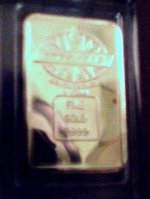heat45
Jr. Member
I've scratched and ruined a Credit Suisse gold bar trying to remove an orange spot before. I now have a rare old Englehard bar with the same discoloration. Any input would be greatly appreciated. I haven't bought Tarnex for a while, but that's what I'll resort to if I can't remove it with some other non-abrasive soaking method. I've also thought of pouring boiling water over it. Has anyone dealt with this issue successfully?






